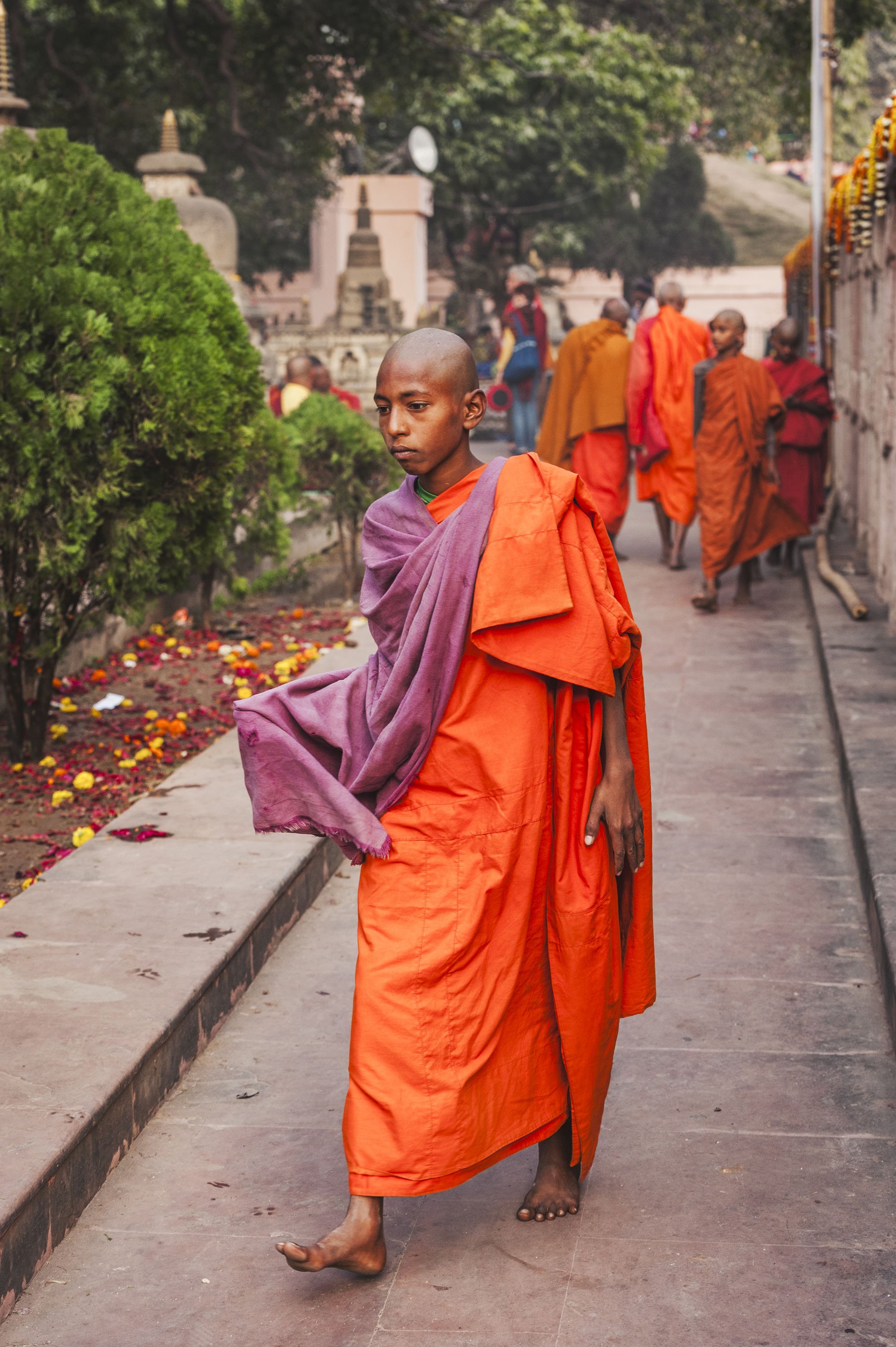India 2013
Bodh Gaya, Bihar

There is no place in the world that Buddhists revere more than Bodh Gaya, in Bihar. Here, is where Gautama Siddharta attained enlightenment, a state of total liberation from lust, hatred, and delusion, thus becoming the Buddha, the Englightened One.
Visiting Bodh Gaya means coming into contact with the light of wisdom that leads to happiness. Every year, during the full moon of May, thousands of pilgrims from various countries, including Nepal, India, Burma, Thailand, China, and Japan, arrive in Bodh Gaya to commemorate the moment when Buddha attained nirvana. The story begins with Siddhartha: he was a prince, born in 563 B.C. in Nepal, who, at the age of 29, renounced his kingdom, his possessions, his wife, and his son and began wandering through the pre-Himalayan hills, pushing to the plains, visiting sacred places like Varanasi on the banks of the Ganges. He searched for the meaning of life, not satisfied with the philosophical explanations of his time. He reached Rajgir and ultimately Gaya, an ancient religious center blessed by the Hindu god Vishnu as the place where all men are forgiven of sins. Siddhartha spent many years in seclusion on the outskirts of Gaya, near the Falgu River, fasting and meditating under a religious pipal tree, for a period of 49 days and nights. During this period, many events occurred that would later find expression in late Buddhist art. According to one of these stories, a great serpent known as Mucalinda emerged from the waters of a storm that seemed to threaten Buddha. The serpent curled around the Buddha seven times, not to suocate him but to protect him. Another story tells of the day when Mara, the eternal temptress, appeared to 35-year-old Buddha, who was seeking truth through meditation, to divert him from his practice and lure him to carnal pleasures. Buddha remained unmoved as he lowered his hand and touched the earth, witnessing his triumph over desire, the root of all human suering. Flowers rained down that night under the full moon and the universe celebrated the victory of wisdom over all else. The young man Siddhartha thus became Buddha, the Enlightened One. The tree under which he sat came to be called the Bodhi Tree and the place Bodh Gaya. The Mahabodhi Temple and the Bodhi tree are both located in the pilgrimage center of Bodh Gaya. For Buddhists, Bodh Gaya is one of the four main pilgrimage sites associated with the life of Gautama Buddha, along with Kushinagar, Lumbini, and Sarnath.
Bodh Gaya exudes an aura of tranquility that envelopes visitors from the moment they arrive. The calm atmosphere of the city, punctuated by the gentle rustle of prayer flags and the melodious chants of monks, creates a heightened sense of peace and contemplation that is unmatched anywhere else. Amidst the bustling streets and vibrant markets, one can find pockets of quiet where the mind can wander and the spirit can soar.
The sacred city of Bodh Gaya is located in the verdant state of Bihar, India, a time-honored haven that is revered by pilgrims and seekers of spiritual enlightenment from all over the world. Steeped in history and spirituality, this ancient city holds profound significance as the birthplace of Buddhism and the site where Lord Buddha achieved enlightenment under the Bodhi tree over 2,500 years ago.
Pilgrims in Bodh Gaya
Maha Bodhi Temple
The Mahabodhi Temple stands as an iconic symbol of enlightenment and spiritual awakening in the Buddhist world. It is a sacred site revered not only by Buddhists but by people of various faiths and backgrounds, drawing pilgrims and visitors from all corners of the globe.
At the heart of the temple complex lies the revered Bodhi Tree, believed to be a direct descendant of the original tree under which Siddhartha Gautama, later known as the Buddha, attained enlightenment over 2,500 years ago. This ancient fig tree, scientifically known as Ficus religiosa, provides a serene canopy under which pilgrims meditate, reflect, and seek inner peace. The architecture of the Mahabodhi Temple is a captivating blend of various styles spanning centuries of history. Its soaring spire, reaching a height of 55 meters, is a testament to the grandeur and spiritual significance of the site. The temple's design, dating back to the 7th century AD and later renovated in the 19th century, reflects the rich cultural heritage of the region. As one enters the temple precincts, a profound sense of reverence and tranquility envelops the soul. Inside, the main shrine houses a magnificent golden statue of the Buddha in a meditative posture, radiating an aura of serenity and enlightenment. Devotees offer prayers, light incense, and make offerings, perpetuating a tradition that has endured for millennia. The Mahabodhi Temple complex is not merely a historical relic but a living testament to the enduring legacy of the Buddha's teachings. It serves as a vibrant hub of spiritual activity, hosting ceremonies, rituals, and meditation sessions conducted by monks and practitioners from diverse Buddhist traditions. In 2002, the Mahabodhi Temple was inscribed as a UNESCO World Heritage Site, recognizing its outstanding universal value and cultural significance. This designation further underscores the temple's status as a sacred pilgrimage destination and a symbol of global cultural heritage. For countless generations, the Mahabodhi Temple has served as a beacon of hope and inspiration, guiding seekers on the path to enlightenment and inner transformation. Its timeless allure continues to draw pilgrims and visitors from around the world, fostering a sense of unity, peace, and harmony among humanity.
Maha Bodhi Temple
Maha Bodhi Temple
Maha Bodhi Temple
Maha Bodhi Temple
Maha Bodhi Temple
Maha Bodhi Temple
Maha Bodhi Temple
Maha Bodhi Temple
Maha Bodhi Temple
Maha Bodhi Temple
Maha Bodhi Temple
Maha Bodhi Temple
Maha Bodhi Temple
Maha Bodhi Temple
Maha Bodhi Temple
Maha Bodhi Temple
Maha Bodhi Temple
Maha Bodhi Temple
Maha Bodhi Temple
Maha Bodhi Temple
Maha Bodhi Temple
Maha Bodhi Temple
Maha Bodhi Temple
Maha Bodhi Temple
Maha Bodhi Temple
Maha Bodhi Temple
Maha Bodhi Temple
Maha Bodhi Temple
Maha Bodhi Temple
Maha Bodhi Temple
v
Maha Bodhi Temple
The pictures of Mahabodhi Temple in Bodh Gaya taken during my trip in India in 2013 published on National Geographic Viajes.
























































